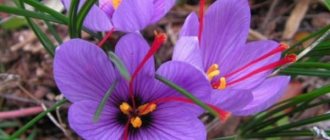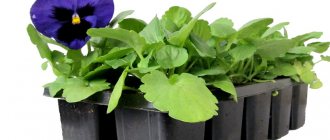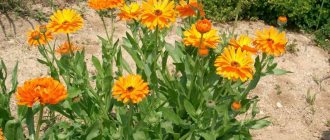Calendula is a beautiful and colorful annual plant that is familiar to almost every person in our country. The plant is very highly valued in folk medicine and pharmacology because the flowers are used as medicinal raw materials. However, not only this is good for the plant, it also has a bright beauty and a smell that repels pests. No one will argue - it’s easier to immediately plant a flower crop in open ground. However, when growing calendula from seeds through seedlings at home, you can achieve earlier flowering.
Description of the plant
Calendula is a species of herbaceous plant belonging to the Asteraceae, or Asteraceae, family. In its natural environment, calendula is found in Western Europe, the Mediterranean and Asia.
Low, up to a maximum of 70 cm, calendula stems are covered with soft hairs. All leaves are covered with the same hairs on the back side. The texture of the inflorescence petals varies from normal to velvety, and the buds themselves at the flowering stage reach 5 cm in diameter.
In addition to medicinal properties, these flowers also exhibit reflection - they always stretch towards the sun, and are popularly called “marigolds”.
How to use calendula as green manure
- How to use calendula as green manure
- Properties and uses of calendula
- Calendula tincture: instructions for use, indications, price
Calendula is an extremely unpretentious annual flower crop. Grows on almost any soil. Calendula has a healing, phytoncidal effect and increases large green mass over the course of a season. Its crumbled seeds are able to germinate even after overwintering in the middle zone. They grow quickly and do not even require additional intervention. So why not sow calendula specifically as a green fertilizer? Having sowed seeds on the site once, you can later collect your own and use them for sowing as green manure.
What does calendula give to the earth?
The plowed green mass, rotting, will provide the soil with nitrogen, biologically active substances, microelements, and food for earthworms. You can use mowed greens as mulch for plants and trees. The smell of calendula is not tolerated by butterflies, mites, and thrips. Phytoncides contained in the plant will disinfect the soil from fungal and other pathogenic infections. Flowers such as gladioli, after planting in soil where calendula has been plowed, are to a small extent affected by thrips. Calendula is one of the best green manures for further cultivation of nightshades: potatoes, eggplants, tomatoes.
What are the benefits of calendula?
No additional cash costs are required to purchase seeds. You can grow them yourself in one summer season. No need to waste time growing seedlings. It can be sown with seeds in the ground from May to the end of summer. Calendula grows quickly. One hundred square meters requires 150-200 g. The green mass is mowed before flowering begins.
Reference. Calendula seeds germinate 7-10 days after sowing. The time from sowing to flowering is 45-50 days. One gram contains about 150-170 seeds. The shelf life of calendula seeds is 2-3 years.
You may also find the following materials useful:
- Favorable days for planting crocuses in 2022 according to the lunar calendar
- Lunar calendar for transplanting, planting and caring for orchids in 2022
- Favorable days for planting dahlias according to the lunar calendar for 2022
- Radishes - how to plant correctly and when in 2022? Planting dates in the table
- Planting onions for seedlings in 2022 according to the lunar calendar, favorable days
Previous materials on the site
- When to plant tulips in 2022 according to the lunar calendar by month
- Planting primrose in 2022: when to sow according to the lunar calendar, timing, cultivation
- Soaking pepper seeds before planting in 2022, when and how to soak according to the lunar calendar
- When to plant tomatoes for seedlings at home, timing of planting tomato seeds in January 2022, lunar calendar of favorable days for seedlings
- Planting celery seedlings in 2022: when to sow, timing
When is calendula planted in the ground?
Marigolds are grown only in hay. And the seeds can be planted immediately in an open area, or seedlings can be grown from them at home. The advantage of pre-germinating seedlings is that the flowers will begin to bloom in early June, which is important for gardening in cold climates. But the plants can easily be sown directly into open ground.
Marigolds are sown immediately in open ground or first in autumn, until frost begins; or from mid-spring, when the soil has already thawed. For a plant with southern ancestry, marigolds tolerate cold quite resistantly and grow already at 4 degrees Celsius, and their seeds are able to survive cold winters. Along with the beauty of the flower and its medicinal properties, its ability to survive in colder climates has made it one of the most common flowers in the world.
There is one small nuance in planting seeds in the fall - if you do not predict the onset of cold weather and sow the seeds a little earlier, so that they have time to hatch, then with the onset of cold weather the seeds will die. But, there is a little trick: make grooves in the soil for sowing in advance, and as soon as the ground freezes, sow the seeds in them and sprinkle them with previously prepared soil at room temperature.
When to plant calendula seedlings: optimal timing
When is it better to plant calendula seedlings in 2022, in what month? At home, it is optimal to sow seeds in the second half of March and April. However, the time may vary depending on the region:
- In the South , you can plant it in mid-March (planted in open ground around the end of April).
- In the middle zone (Moscow region) - it is better to sow in early April (planting in a permanent place in mid-May).
- In Siberia, the Urals, Leningrad region - in mid-April (planted in open ground at the end of May or early June).
According to the Lunar calendar 2022
Favorable days:
- in March - 2, 3, 4, 5, 6, 7, 8, 10, 11, 12, 13, 14, 29, 30, 31;
- in April - 1, 2, 5, 6, 7, 9, 18, 19, 20, 24, 25.
Unfavorable days:
- in March - 9, 19, 20, 21, 24;
- in April - 8, 15, 16, 17, 23.
Soil preparation
You can plan to grow marigolds only for the next season. These are the features of soil preparation at the site of the planned plantings. They begin to prepare the soil in the fall:
- The area is dug up several times to the depth of a shovel, so that the soil becomes loose and pliable to mixing.
- For one square meter of plot, about one tablespoon of phosphorus and potassium fertilizers and about four kilograms of compost are mixed into the soil.
- For clay soils, coarse sand is additionally added, approximately 7 liter bucket per square meter.
A simpler, more rustic way is to replace fertilizers with stove ash.
When and how to sow calendula
To determine whether you can start sowing calendula in the spring, you should take a handful of soil and squeeze it in your fist. Then the lump of earth must be thrown from about a meter in height. If the soil crumbles completely, you can sow the seeds.
In about two weeks, you should dig up the selected area with a bayonet and embed fertilizer into the ground. For each square of flowerbed add 20 g of potassium, 4 kg of humus and 30 g of urea.
Many gardeners advise preparing the area for calendula in this way in the fall. But only in this case should fertilizers with nitrogen be added to the soil in the spring.
Calendula seeds are sown in grooves or holes about 2 cm deep. At the same time, a step of about 60 cm is left between plants in the row. If calendula officinalis is sown, only 10 cm can be left between plants. But the row spacing should be at least 30 cm.
After sowing calendula, cover the seeds with soil, lightly compact it and irrigate it with a sprinkler. After just a week, shoots will appear. After 20 days, it will be possible to thin out the seedlings if the seedlings appear too dense. A minimum of 25 cm should be left between bushes for low-growing varieties.
After about two months, the calendula will begin to bloom. Varieties have been bred that bloom profusely right up to frost. Cut varieties can be planted in July for late flowering.
Preparation of planting material
Seeds for sowing can be obtained in a variety of ways:
Ask your neighbors in your summer cottage, and most likely you will receive them with detailed instructions for growing and caring for them.
Choose a variety on the Internet and buy it in an online store, or in any specialized store in your city. If you can buy seeds in a regular store, it is better to use this option. To order seeds online, personal recommendations from an online store will not hurt.
Collect the seeds from the plant yourself if you are already growing them.
It's fun to experiment with marigolds: mix different varieties and observe the results of cross-pollination, collect seeds and get a variety of plants each next generation.
After everything is determined with the choice of seeds, you need to sift them. Of all the grains that you have, you need to choose dummies and the smallest seeds. You can sit and select seeds with tweezers, or you can use a faster method - pour all the seeds into a water-salt solution, and all the debris will float to the surface, while the good seeds will remain at the bottom.
Why gardeners love calendula
Low varieties up to 30 cm high grow well on the balcony and in outdoor flower pots in the company of petunias, ageratum, and bacopa. Tall representatives of the species (70-80 cm) are good for the background.
Gardeners like “early ripening” calendula: cultivation from germination to flowering takes 1.5-2 months . Cold resistance allows you to sow it early: 2-4⁰C is enough for seed germination; seedlings are not afraid of light frosts. And already in early-mid June the first bright baskets appear.
Caring for marigolds is simple : weeding, loosening the soil, fertilizing with fertilizers in the spring and first half of summer along with other flowers.
The plant gives excellent self-seeding - the seeds scatter throughout the area and germinate spontaneously: leave it where necessary next year or weed it out. So you only have to plant calendula once and it will always self-sow in the same place.
Calendula is unpretentious to the substrate - neutral, slightly acidic soils with a pH of 6.5-7 are suitable for it. Despite its southern origin, the species adapts flexibly to the range of climatic conditions from Crimea to Arkhangelsk.
All these qualities of the plant are attractive for arranging a garden landscape in a “rustic style”. Thus, the mixture of “Moorish” lawn seeds includes flax, gum, annual poppies and calendula: growing an unpretentious flowering meadow is one of the steps to a minimum-care garden.
Planting process
Marigolds can easily withstand cold temperatures down to -5 degrees, which allows them to be sown immediately in the open air, without wasting time on growing seedlings.
When the seeds are ready:
- Planting begins with the correct selection of the site. The area should be well lit most of the day. In the shade, flowers grow more elongated with small buds and bloom less profusely.
- The soil, prepared since last autumn, is loosened and fertilizers containing phosphorus, nitrogen and potassium are added to it.
- The fertilized area is leveled with a rake and is ready for sowing. If everything is done correctly, the site will be fertile for the next five years.
- Depending on what kind of flower pattern you want to get, the area is schematically divided into equal cells and holes are made in the corners of each cell, or you can make furrows, draw with them, or distribute them in rows. The distance between holes should be at least 40cm, and between rows about 50cm. The depth of any planting is no more than 4 cm - if you plant the seeds deeper, this will reduce the percentage of their germination.
- If seeds are sown immediately, they are distributed 2-3 seeds per hole, or 2-3 seeds in a row at a distance of about 20 centimeters from each other. They are sown no deeper than one centimeter.
- Planting seedlings follows the same pattern, except that per hole and per planting in a row there is one seedling in place of several grains.
Features of care
Marigolds are easy to care for; all that is required is timely watering, weeding and fertilizing of the flowers. If you add fertilizer to the soil before planting, then throughout the summer you can refuse fertilizing altogether, or carry it out in small quantities.
To increase the volume of green mass on the plant, nitrogen fertilizers should be introduced into the soil at the beginning of the planting season. You can use cow or bird manure to feed calendula.
To extend the flowering period, the plant can be sprayed with complex fertilizer containing boron.
Feeding and watering
Marigolds love high levels of humidity and die if the soil dries out, but there are certain features associated with watering.
Note! Only young plants need regular watering; adult flowers are watered only when the soil is completely dry.
Seedlings planted in the ground need watering up to 4 times a week, until the flowering period; if the precipitation level is optimal, the plant can be watered 2 times a week. As soon as the calendula blooms, you can stop watering if it rains at least once a week.
If fertilizers were not introduced into the soil before planting, you need to feed the flowers once every 2 weeks. Fertilizing should be done with complex fertilizers Ammophos or Nitrophoska. If there is too much fertilizer, the vegetation may die.
Note! With an excess of nitrogenous fertilizers, calendula begins to bloom poorly, and the buds have a pale tint.
Reproduction
Reproduction of the flower is carried out by collecting seeds. The ripening of the seed occurs towards the end of summer. Externally, the seeds resemble a brown crescent with ribbed edges.
To prepare seed, you need to pick off the inflorescences along with the seeds, spread them on a gauze pad and place them in a dark room with good ventilation for subsequent drying.
After the seeds are completely dry, they are separated from the buds and placed in an airtight jar or linen bags and stored in a dry place with a humidity not exceeding 40%.
Growing calendula from seeds
Calendula planting. Growing from seedling grains occurs according to the following scenario:
A container for seedlings is selected and prepared. It should have drainage holes. If there are none, you need to do them yourself.
Store-bought sowing mixtures work well as soil.
The seeds are sown evenly in the prepared container and lightly sprinkled with soil.
The container is covered with film and stored at room temperature until the first shoots appear. After the first shoots appear, the film is removed.
When the shoots get stronger and produce the first couple of petals, they can be planted in separate containers.
The sprouts finally grow stronger and become ready for transplanting to the site one month after the first shoots appear.
Planting calendula seeds in open ground
As a rule, marigolds begin to sow closer to the beginning of autumn. It is best when this is done in early September or late August. If you decide to plant in the spring, then this can be done as soon as the soil is ready for planting. To check this, you need to take it into your fist and squeeze it, after which the resulting lump must be thrown from a height of a meter. If the soil crumbles easily, then sowing can begin.
Before planting a flower, the open soil must be dug up and fertilized. Humus is suitable for this, which must be applied in a proportion of 3 kg per 1 m2 of soil.
In addition to humus, you can also use some types of fertilizers. So, you can pour a solution with potassium sulfate, superphosphate and urea into the ground. Each substance needs 1 spoon per 1.5 liters of water. This solution is enough for 1 m2 of soil.
The fertilized soil is thoroughly dug up and leveled. After all procedures, you can start sowing. Experts advise planting marigolds in rows. To do this, it is enough to draw shallow grooves in the area where sowing will be done. Their depth should not exceed 2 cm. This is necessary to make it easier for the seedlings to overcome the soil layer. The distance between the grooves should not be less than 30 cm, since after the flowers grow, they may become crowded.
So, caring for calendula in open ground is not difficult: for optimal development of the plant, only timely watering is necessary. Planting this flower is also easy; it takes root well in a suitable soil mixture.
“Marigolds” will decorate any summer cottage. And thanks to their medicinal properties, they can also be used as a folk remedy.
Rules for caring for calendula
In order for your nails to be lush and breathe health and freshness, regular care measures are necessary:
- Timely watering and fertilizing.
- When the shoots are completely strong and are ready to soon become adult plants, sprinkle the soil at the base of its stems with mulch made from hay and chopped tree bark. Such a fur coat will help maintain moderate humidity even in dry seasons and will help cool the roots.
- Trim bushes periodically.
- Regularly weed after watering and carefully loosen the top layer of soil. This will give the roots an influx of oxygen and prevent water stagnation.
Sowing and growing calendula seedlings step by step with photos
For seedlings, marigold seeds are planted in deep plastic containers with drainage holes, boxes or individual pots. The containers are filled with moist flower soil.
The seeds are buried 2 cm into the ground, sprinkled with soil on top, sprayed with warm water from a spray bottle and covered with cling film or cellophane. Crops are placed in a warm place with an air temperature of +20 degrees.
Every day, the film will need to be removed for a few minutes to ventilate the substrate and check its humidity. As soon as the top layer of soil begins to dry out, it will need to be sprayed with water at room temperature.
In about a week, seedlings will begin to appear, which will need to be moved to a well-lit, cool place with an air temperature within +15 degrees.
Caring for calendula seedlings includes:
- Timely moistening of the soil. It is not recommended to over-moisten the soil, as plants may be affected by blackleg.
- Fertilize once every 7-10 days with mineral fertilizers, the concentration of which should be approximately two times less than what is written in the instructions.
- It is necessary to pick marigold seedlings after two true leaves appear on the plants. They are planted in disposable cups or peat pots and flower soil is used. After picking, the plants are watered and placed in the shade for 2-3 days, where the sun's rays do not reach.
If calendula was grown to decorate a balcony, then when picked, it can be immediately planted in flowerpots, balcony boxes or pots.
You will be interested to know: Planting rose seedlings in open ground in the fall: step-by-step instructions with video
Diseases and pests
Basically, marigolds are resistant to all kinds of diseases. The most dangerous pest among insects for them is aphids. In the fight against it, ordinary insecticides and loosening the soil around the stems will help to destroy the paths of the ants that brought this aphid.
Among fungal diseases, you should be wary of powdery mildew and circosporosis. The main cause of diseases is stagnation of water and high humidity. It is treated by eliminating the sickest plants. Treating all bushes with fungicides will also bring a beneficial effect.
Interesting varieties
We usually associate calendula with yellow and orange flowers, but breeders are constantly working to produce new, interesting varieties. Now the flowers come in a variety of shades, from bright to subtle, ranging from lemon, grapefruit, bright orange (Ball's Orange variety), creamy white (Calendula officinalis - "Snow Princess"), to pink. Sometimes the flowers are two-colored with contrasting tips of the petals (varieties “Sunny Girl” Sunny Girl and “Sherbet Fizz” Sherbet Fizz).
"Snow Princess" Snow Princess
We can purchase a variety of varieties, and the possibilities for arranging have expanded using the beauty of these plants. The height of calendula varies depending on the varieties from 15 cm for dwarf varieties to 70 cm for the tallest ones.
Among the cultivated ornamental varieties there are also varieties with two-color flowers. Calendula looks great with double flowers and needle-shaped inflorescences. It is worth choosing dwarf varieties for the balcony.
- “Empress” is a calendula variety with double orange flowers, 50 cm high. Flowering begins in July.
- “Princess” Princess is a tall variety with light orange flower baskets.
- "Green Heart Gold" Greenheart gold is a variety with a green center, represented by green, tubular flowers and yellow reed flowers.
- "Porcupine" Porcupine - the flower looks like a small dahlia with ruffled petals that gradually lengthen.
- "Greenheart Orange" Greenheart Orange - the middle of the inflorescence is formed by a huge number of reed flowers, forming a flattened pom-pom.
- “Luch” is a compact variety with double, orange flowers.
- “Fiesta Gitana” Fiesta Gitana – flowering period from June to October, height – 30 cm. Flowers in the form of pompoms of different colors: lemon yellow, pale yellow, orange, orange-yellow. A dwarf variety ideal for borders.
- "Pink Surprise" Pink Surprise - a variety 60 cm high, flower colors - orange, yellow, salmon pink.
- “Prince of India” Indian Prince is a calendula variety with double flowers of dark orange color with a brown center, height – 60 cm. Blooms from June to September.
- “Cream Beauty” Cream Beauty is a variety with double, cream flowers.
- “Radio” Radio is a variety with double, needle-shaped yellow flowers.
- "Santana" Santana - double flowers.
- "Apricot Beauty" Apricot Beauty is a beautiful variety with double apricot flowers.
- "Tokai" Tokaj - has yellow inflorescences.
- "Ball's Orange" Ball's Orange - shoot height reaches 60 cm. Suitable for bouquets.
- “Citrus cocktail” Citrus Cocktail - stems reach a maximum of 20 cm, the variety is suitable for growing in pots on the balcony.
- “Fruit Twist” Fruit Twist is a dwarf calendula variety (15 cm) with yellow and orange flowers.
Popular types
Of the entire diversity of the genus, two popular species have gone to the general public: field and medicinal calendula.
Field
Wild subspecies. Loves to grow in abandoned areas and front gardens. Extremely tenacious, the bushes grow up to 30cm in height and bloom in small yellow inflorescences.
Medicinal
Nowadays, medicinal calendula is grown on an industrial scale:
Substances contained in the plant promote wound healing, disinfect them, destroy bacteria, relieve fever and painful inflammation. It is not surprising that in the times of Ancient Greece miraculous qualities were attributed to it.
If it is necessary to rid the body of excess bile, then calendula infusion has strong choleretic properties.
A tincture from the plant will help cure severe sore throat.
In the form of an ointment based on calendula, it promotes the healing of burns, bruises, and can cope with the disinfection of serious wounds.
Also, the tincture can help fight gastrointestinal infections and liver inflammation.
How to care for calendula seedlings
The culture is not whimsical, so there will be no difficulties in caring for calendula seedlings at home after sowing and before planting; there are no special tricks. To properly care for plants, you must follow these recommendations:
- Immediately after sowing and before the emergence of seedlings, it is necessary to maintain a temperature of 18-20 degrees Celsius, and after that the temperature must be reduced slightly - to +16-17°C.
- After germination, you need to move the plants to a sunny windowsill. Plants should receive lighting for at least 12 hours, and additional lighting if necessary.
- If the plants become elongated when growing seedlings, then the conditions should be changed: you need to lower the temperature slightly, provide full lighting (at least 12 hours). If the plants are very elongated, you can add a little soil and also water them with a solution of the Atlet preparation, which helps fight elongation (stimulates root growth and inhibits the development of the above-ground part).
- 10 days before planting plants in open ground, in a permanent place, it is recommended to feed the plants with mineral complex or humic fertilizer for seedlings (according to the instructions for the preparation). Fertilizing will help to grow strong calendula.
- If you initially planted them in a common box, bowl or small cups, then you need to pick when the calendula seedlings have 2 true leaves. You need to use an individual container, deepen it to the cotyledon leaves.
- Plants should be planted in a permanent place in open ground when 5-6 true leaves have grown. At the same time, the soil should warm up, and the threat of return frosts should pass.
Choosing a landing site
The plant is not too demanding - it will grow successfully even on weak soils. It looks beautiful, has a pleasant aroma, and the dried raw materials can be used to prepare many preparations. The plant gives good self-seeding, seedlings are quickly accepted, tolerate cold well, so the plant will quickly spread in the flowerbed or beds.
Growing calendula officinalis is not particularly difficult, but it is necessary to provide it with an appropriate position. The plant loves warm, well-lit areas, only in such conditions it blooms profusely. Calendula also grows well in partial shade, but the flowering is much more modest. It is not afraid of too much sun - even in southern exposure the plant develops well.
To plant calendula, you should choose a place protected from strong winds, which can break the rather fragile stems.
Soil requirements
The plant is undemanding to soil and can grow on all types of soil, including poor, limestone. However, the best soil for calendula is:
- moderately fertile;
- well drained;
- the plant is tolerant of soil reactions and can withstand a wide pH range: 4.5-8.0.
The species grows well accompanied by tomatoes.
Calendula appreciates light soils; drainage on heavy soils can be improved with a small amount of coarse river sand.
Calendula can be planted in pots and grown on the balcony. The pot should be wide enough. The greatest chances for abundant flowering will be on south-facing balconies.
Application
For many years, calendula has been known as a valuable medicinal plant, which, due to its properties, is used to treat several ailments. The flower has also found use in cosmetics and is a main ingredient in many cosmetic preparations. The plant can also be planted for decorative purposes.
In the garden
Calendula is often grown in country houses and garden plots. The plant easily disperses itself, remaining on the site for several years. From the beginning of summer until frost, it will decorate the garden with many small flowers, reminiscent of daisies, in cheerful yellow, orange or even pink. Calendula allows you to fill gaps in perennial or annual flower beds to keep the decor blooming until early fall.
Marigolds are used mainly in flower beds; miniature varieties can be planted as a border plant, and also complement flower arrangements located on the balcony and terrace.
In pots you can make compositions with:
- marigolds;
- zinnias;
- dwarf dahlias.
In a naturalistic mixed style, calendula flowers will harmoniously combine with other annual flowers:
- daisies;
- belly buttons;
- osteospermum;
- in succession.
Also combines with summer flowering perennials:
- echinacea;
- yarrow;
- sage.
Dwarf marigolds form flower cushions that will decorate the base of rose bushes, buddleia, and hibiscus.
Photo. Calendula in the garden
In a large flowerbed, in combination with immortelle petiolate or chistets, calendula is a good company for more slender summer plants:
- catchment;
- verbena;
- lupine;
- coreopsis;
- gaillardia;
- daylilies.
Calendula helps bring color to the garden at a slightly less bloomy time of year - late summer; it awakens compositions devoid of summer bloom. In autumn, it goes well with late perennials - rudbeckias, asters, helenium, immortelle.
With its bright flowers, the plant adds cheerfulness and lightness to rock gardens. In a sunny rock garden it will be an ideal companion for other low-growing plants - lantana, sedum.
In a more modern composition, the silhouette of calendula is emphasized by graphic and light herbs such as pennisetum.
Calendula is also suitable for bouquets.
Calendula is one of the best honey plants; it must be planted not only in flower beds, but also in the garden and greenhouse. Its smell repels nematodes and aphids, so the flower is planted near strawberries and tomatoes. The flowers attract many pollinating insects and are a plant that actively contributes to biodiversity.
Medicinal plant
Calendula officinalis has long been used for medicinal purposes. The first mention of its use in medicine dates back to the 12th century. For medicinal purposes, whole or crushed, dried, fully developed flowers are used.
Calendula owes its remarkable healing properties to its rich content of active substances. The plant contains triterpene alcohols and saponins, which have diuretic and expectorant properties. Saponins are often included in anti-inflammatory, antibacterial and antiviral drugs.
Calendula flower also contains essential oil, carotenoids, malic acid, and is a rich source of complex sterols, flavonoids and polyphenolic compounds, which have very powerful antioxidant properties and can effectively fight free radicals. The flowers also contain a lot of organic acids, resins, polysaccharides, vitamin C and mineral salts.
An infusion of calendula flowers is used externally: for washing, compresses, and rinsing. It is used internally for inflammation of the gastrointestinal tract. Calendula, thanks to its ability to destroy microbes, helps protect the mucous membrane of the stomach and intestines and stimulates regenerative processes.
Externally, alcohol tinctures of calendula flowers and oil extracts are usually used, since the main active compounds are not soluble in water. They have anti-inflammatory and bactericidal properties against staphylococci and streptococci. Rinsing with calendula infusion is used to treat inflammation of the mouth, throat and larynx.
The plant is used for various skin lesions (traumas, wounds, ulcers, bruises), dermatitis, skin rashes. Some forms are used on mucous membranes, used in the treatment of inflammation of the conjunctiva and eye fatigue (they are an integral part of some eye drops).
The most popular is homemade calendula ointment. This is a wonderful drug that is very effective for burns, rashes and eczema. It is excellent for treating difficult to heal wounds. Calendula ointment has a nourishing and anti-inflammatory effect on the skin.
Lard ointment recipe
The oldest recipe is very simple, but somewhat surprising. A cube of lard needs to be heated in a saucepan, after which 2 large handfuls of fresh or dried calendula petals are added. Both ingredients need to be boiled, stirring constantly. When it cools down, you need to heat the lard again, strain everything and pour it into a jar. Calendula ointment should be stored in the refrigerator and used as needed.
Olive oil recipe
According to another recipe, the ointment can be made from fresh calendula petals, which need to be finely chopped and add 100-150 ml of olive oil. The mixture is heated over low heat for about 30 minutes. Then you need to strain and for a better consistency add 20 g of melted beeswax. Transfer the finished mixture into small jars and refrigerate. Calendula ointment can be stored in the refrigerator for several weeks.
In cosmetology
Due to its healing properties, calendula is used in hand creams used for frostbite and burns. It is also a component of masks and face creams, shampoos.
In cooking
Edible calendula flowers are valued in herbal teas, infusions, and salads. They are used to decorate desserts and cakes. They are also used to make food coloring and are used to color margarines, cheeses, and rice. For this property, calendula is called “artificial saffron.”
Calendula is associated primarily with country-style gardens. A wide selection of beautiful varieties will allow you to rediscover the beauty of this plant and include it in the decoration of your garden, balcony, or terrace. The flower can be grown in the garden, where it repels pests, and used in cooking in salads, herbal teas or infusions. It is also worth studying the healing properties of the plant.











